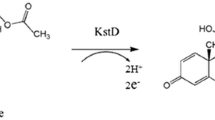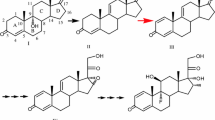Abstract
A previously unidentified oxidoreductase from Escherichia coli catalyzes the regioselective reduction of eukaryotic steroid hormone 11-deoxycorticosterone (11-DOC) to the valuable bioactive product 4-pregnen-20,21-diol-3-one. In nature, a reduction of C-20 carbonyl of C21 steroids is catalyzed by diverse NAD(P)H-dependent oxidoreductases. Enzymes that possess 20-ketosteroid reductase activity, however, have never before been described in E. coli. Our present study aimed to identify and characterize the E. coli enzyme which possesses 20-ketosteroid reductase activity against eukaryotic steroid hormone 11-DOC. We partially purified the enzyme from E. coli DH5α using protein chromatography techniques. Mass spectrometry revealed the presence of three NADH-specific oxidoreductases in the sample. The genes encoding these oxidoreductases were cloned and overexpressed in E. coli UT5600 (DE3). Only the overexpression of 2-dehydro-3-deoxy-d-gluconate 5-dehydrogenase (KduD) encoded by kduD gene enabled the whole-cell biotransformation of 11-DOC. A 6xHis-tagged version of KduD was purified to homogeneity and found to reduce several eukaryotic steroid hormones and catalyze the conversion of novel sugar substrates. KduD from E. coli is therefore a promiscuous enzyme that has a predicted role in sugar conversion in vivo but can be used for the production of valuable bioactive 20-hydroxysteroids.





Similar content being viewed by others
References
Allner R, Eggstein M (1976) Untersuchungen uber die Substratspezifitat einer 3alpha, 20beta-Hydroxysteroid:NAD+-oxidoreductase. J Clin Chem Clin Biochem 14:59–64
Asada Y, Endo S, Inoue Y, Mamiya H, Hara A, Kunishima N, Matsunaga T (2009) Biochemical and structural characterization of a short-chain dehydrogenase/reductase of Thermus thermophilus HB8: a hyperthermostable aldose-1-dehydrogenase with broad substrate specificity. Chem Biol Interact 178(1–3):117–126
Barski OA, Tipparaju SM, Bhatnagar A (2008) The aldo-keto reductase superfamily and its role in drug metabolism and detoxification. Drug Metab Rev 40(4):553–624
Bausch C, Peekhaus N, Utz C, Blais T, Murray E, Lowary T, Conway T (1998) Sequence analysis of the GntII (subsidiary) system for gluconate metabolism reveals a novel pathway for l-idonic acid catabolism in Escherichia coli. J Bacteriol 180(14):3704–3710
Beranic N, Gobec S, Rizner TL (2011) Progestins as inhibitors of the human 20-ketosteroid reductases, AKR1C1 and AKR1C3. Chem Biol Interact 191(1–3):227–233
Black HE (1988) The effects of steroids upon the gastrointestinal tract. Toxicol Pathol 16(2):213–222
Chen QX, Nancarrow CD, Sweet F (1987) Isolation of 3 beta,20 alpha-hydroxysteroid oxidoreductase from sheep fetal blood. Steroids 49(6):477–496
Chetrite GS, Thole HH, Philippe JC, Pasqualini JR (2004) Dydrogesterone (Duphaston) and its 20-dihydro-derivative as selective estrogen enzyme modulators in human breast cancer cell lines. Effect on sulfatase and on 17beta-hydroxysteroid dehydrogenase (17beta-HSD) activity. Anticancer Res 24(3a):1433–1438
Condemine G, Hugouvieuxcottepattat N, Robertbaudouy J (1984) An enzyme in the pectinolytic pathway of Erwinia chrysanthemi 2-keto-3-deoxygluconate oxidoreductase. J Gen Microbiol 130(Nov):2839–2844
Cremonesi P, Carrea G, Ferrara L, Antonini E (1975) Enzymatic preparation of 20 beta-hydroxysteroids in a two-phase system. Biotechnol Bioeng 17(8):1101–1108
De Amici M, De Micheli C, Molteni G, Pitre D, Carrea G, Riva S, Spezia S, Zetta L (1991) Chemoenzymic synthesis of the eight stereoisomeric muscarines. J Org Chem 56(1):67–72
Donova MV, Egorova OV (2012) Microbial steroid transformations: current state and prospects. Appl Microbiol Biotechnol 94(6):1423–1447
Duport C, Spagnoli R, Degryse E, Pompon D (1998) Self-sufficient biosynthesis of pregnenolone and progesterone in engineered yeast. Nat Biotechnol 16(2):186–189
Earhart CF, Lundrigan M, Pickett CL, Pierce JR (1979) Escherichia coli K-12 mutants that lack major outer membrane protein a. FEMS Microbiol Lett 6(5):277–280
Faramarzi MA, Tabatabaei Yazdi M, Amini M, Zarrini G, Shafiee A (2003) Microbial hydroxylation of progesterone with Acremonium strictum. FEMS Microbiol Lett 222(2):183–186
Fokina VV, Sukhodolskaya GV, Baskunov BP, Turchin KF, Grinenko GS, Donova MV (2003) Microbial conversion of pregna-4,9(11)-diene-17alpha,21-diol-3,20-dione acetates by Nocardioides simplex VKM Ac-2033D. Steroids 68(5):415–421
Hannemann F, Bernhardt R, Jose J (2007) Biocatalytic synthesis of 4-pregnen-20,21-diol-3-one, a selective inhibitor of human 5alpha-reductase type II. J Enzym Inhib Med Chem 22(5):570–576
Hantz O (1977) La voie dégradative secondaire du 2 céto 3 desoxygluconate chez Escherichia coli. Oxydation enzymatique du 2 céto 3 desoxygluconate. Dissertation, Claude Bernard University
Hickman J, Ashwell G (1960) Uronic acid metabolism in bacteria. II. Purification and properties of d-altronic acid and d-mannonic acid dehydrogenases in Escherichia coli. J Biol Chem 235:1566–1570
Hoffmann F, Maser E (2007) Carbonyl reductases and pluripotent hydroxysteroid dehydrogenases of the short-chain dehydrogenase/reductase superfamily. Drug Metab Rev 39(1):87–144
Inazu A, Sato K, Nakayama T, Deyashiki Y, Hara A, Nozawa Y (1994) Purification and characterization of a novel dimeric 20 alpha-hydroxysteroid dehydrogenase from Tetrahymena pyriformis. Biochem J 297(Pt 1):195–200
Jeong H, Barbe V, Lee CH, Vallenet D, Yu DS, Choi SH, Couloux A, Lee SW, Yoon SH, Cattolico L, Hur CG, Park HS, Segurens B, Kim SC, Oh TK, Lenski RE, Studier FW, Daegelen P, Kim JF (2009) Genome sequences of Escherichia coli B strains REL606 and BL21(DE3). J Mol Biol 394(4):644–652
Jose J, von Schwichow S (2004) “Cystope tagging” for labeling and detection of recombinant protein expression. Anal Biochem 331(2):267–274
Kavanagh KL, Jornvall H, Persson B, Oppermann U (2008) Medium- and short-chain dehydrogenase/reductase gene and protein families: the SDR superfamily: functional and structural diversity within a family of metabolic and regulatory enzymes. Cell Mol Life Sci 65(24):3895–3906
Krafft AE, Hylemon PB (1989) Purification and characterization of a novel form of 20 alpha-hydroxysteroid dehydrogenase from Clostridium scindens. J Bacteriol 171(6):2925–2932
Ma H, Penning TM (1999) Characterization of homogeneous recombinant rat ovarian 20alpha-hydroxysteroid dehydrogenase: fluorescent properties and inhibition profile. Biochem J 341(Pt 3):853–859
Mao J, Duan RW, Zhong L, Gibori G, Azhar S (1997) Expression, purification and characterization of the rat luteal 20 alpha-hydroxysteroid dehydrogenase. Endocrinology 138(1):182–190
Nagahama Y (1997) 17 alpha,20 beta-Dihydroxy-4-pregnen-3-one, a maturation-inducing hormone in fish oocytes: mechanisms of synthesis and action. Steroids 62(1):190–196, d
Naidansuren P, Park CW, Kim SH, Nanjidsuren T, Park JJ, Yun SJ, Sim BW, Hwang S, Kang MH, Ryu BY, Hwang SY, Yoon JT, Yamanouchi K, Min KS (2011) Molecular characterization of bovine placental and ovarian 20alpha-hydroxysteroid dehydrogenase. Reproduction 142(5):723–731
Nakajin S, Ohno S, Aoki M, Shinoda M (1989) 20 beta-Hydroxysteroid dehydrogenase of neonatal pig testis: cofactor requirement and stereospecificity of hydrogen transfer from nicotinamide adenine dinucleotide phosphate, reduced form. Chem Pharm Bull 37(1):148–150
Nancarrow CD, Sharaf MA, Sweet F (1981) Purification of 20 alpha-hydroxysteroid oxidoreductase from bovine fetal erythrocytes. Steroids 37(5):539–553
Naumann JM, Messinger J, Bureik M (2010) Human 20alpha-hydroxysteroid dehydrogenase (AKR1C1)-dependent biotransformation with recombinant fission yeast Schizosaccharomyces pombe. J Biotechnol 150(1):161–170
Naumann JM, Zollner A, Dragan CA, Messinger J, Adam J, Bureik M (2011) Biotechnological production of 20-alpha-dihydrodydrogesterone at pilot scale. Appl Biochem Biotechnol 165(1):190–203
Noda K, Shiota K, Takahashi M (1991) Purification and characterization of rat ovarian 20 alpha-hydroxysteroid dehydrogenase. Biochim Biophys Acta 1079(1):112–118
Oppermann UC, Maser E (2000) Molecular and structural aspects of xenobiotic carbonyl metabolizing enzymes. Role of reductases and dehydrogenases in xenobiotic phase I reactions. Toxicology 144(1–3):71–81
Pakkianathan BC, Singh NK, Krishnan M, Konig S (2012) A proteomic view on the developmental transfer of homologous 30 kDa lipoproteins from peripheral fat body to perivisceral fat body via hemolymph in silkworm, Bombyx mori. BMC Biochem 13:5
Penning TM (2003) Hydroxysteroid dehydrogenases and pre-receptor regulation of steroid hormone action. Hum Reprod Update 9(3):193–205
Powell AJ, Read JA, Banfield MJ, Gunn-Moore F, Yan SD, Lustbader J, Stern AR, Stern DM, Brady RL (2000) Recognition of structurally diverse substrates by type II 3-hydroxyacyl-CoA dehydrogenase (HADH II)/amyloid-beta binding alcohol dehydrogenase (ABAD). J Mol Biol 303(2):311–327
Ridlon JM, Ikegawa S, Alves JMP, Zhou B, Kobayashi A, Iida T, Mitamura K, Tanabe G, Serrano M, De Guzman A, Cooper P, Buck GA, Hylemon PB (2013) Clostridium scindens: a human gut microbe with a high potential to convert glucocorticoids into androgens. J Lipid Res 54(9):2437–2449
Rimsay RL, Murphy GW, Martin CJ, Orr JC (1988) The 20 alpha-hydroxysteroid dehydrogenase of Streptomyces hydrogenans. Eur J Biochem 174(2):437–442
Rodionov DA, Mironov AA, Rakhmaninova AB, Gelfand MS (2000) Transcriptional regulation of transport and utilization systems for hexuronides, hexuronates and hexonates in gamma purple bacteria. Mol Microbiol 38(4):673–683
Rodionov DA, Gelfand MS, Hugouvieux-Cotte-Pattat N (2004) Comparative genomics of the KdgR regulon in Erwinia chrysanthemi 3937 and other gamma-proteobacteria. Microbiology 150(Pt 11):3571–3590
Rothe M, Alpert C, Loh G, Blaut M (2013) Novel insights into E. coli’s hexuronate metabolism: KduI facilitates the conversion of galacturonate and glucuronate under osmotic stress conditions. PLoS One 8(2):e56906
Sato F, Takagi Y, Shikita M (1972) 20-Hydroxysteroid dehydrogenase of porcine testes. J Biol Chem 247(3):815–823
Senthilkumaran B, Sudhakumari CC, Chang XT, Kobayashi T, Oba Y, Guan G, Yoshiura Y, Yoshikuni M, Nagahama Y (2002) Ovarian carbonyl reductase-like 20beta-hydroxysteroid dehydrogenase shows distinct surge in messenger RNA expression during natural and gonadotropin-induced meiotic maturation in nile tilapia. Biol Reprod 67(4):1080–1086
Sreenivasulu G, Senthilkumaran B (2009) New evidences for the involvement of 20beta-hydroxysteroid dehydrogenase in final oocyte maturation of air-breathing catfish. Gen Comp Endocrinol 163(3):259–269
Strickler RC, Tobias B, Covey DF (1981) Human placental 17 beta-estradiol dehydrogenase and 20 alpha-hydroxysteroid dehydrogenase. Two activities at a single enzyme active site. J Biol Chem 256(1):316–321
Szczebara FM, Chandelier C, Villeret C, Masurel A, Bourot S, Duport C, Blanchard S, Groisillier A, Testet E, Costaglioli P, Cauet G, Degryse E, Balbuena D, Winter J, Achstetter T, Spagnoli R, Pompon D, Dumas B (2003) Total biosynthesis of hydrocortisone from a simple carbon source in yeast. Nat Biotechnol 21(2):143–149
Tanaka M, Ohno S, Adachi S, Nakajin S, Shinoda M, Nagahama Y (1992) Pig testicular 20 beta-hydroxysteroid dehydrogenase exhibits carbonyl reductase-like structure and activity. cDNA cloning of pig testicular 20 beta-hydroxysteroid dehydrogenase. J Biol Chem 267(19):13451–13455
Taves MD, Gomez-Sanchez CE, Soma KK (2011) Extra-adrenal glucocorticoids and mineralocorticoids: evidence for local synthesis, regulation, and function. Am J Physiol Endocrinol Metab 301(1):E11–E24
Terada T, Sugihara Y, Nakamura K, Sato R, Sakuma S, Fujimoto Y, Fujita T, Inazu N, Maeda M (2001) Characterization of multiple Chinese hamster carbonyl reductases. Chem Biol Interact 130–132(1–3):847–861
Warren JC, Murdock GL, Ma Y, Goodman SR, Zimmer WE (1993) Molecular cloning of testicular 20 alpha-hydroxysteroid dehydrogenase: identity with aldose reductase. Biochemistry 32(6):1401–1406
Wintergalen N, Thole HH, Galla HJ, Schlegel W (1995) Prostaglandin-E2 9-reductase from corpus luteum of pseudopregnant rabbit is a member of the aldo-keto reductase superfamily featuring 20 alpha-hydroxysteroid dehydrogenase activity. Eur J Biochem 234(1):264–270
Wu X, Knapp S, Stamp A, Stammers DK, Jornvall H, Dellaporta SL, Oppermann U (2007) Biochemical characterization of TASSELSEED 2, an essential plant short-chain dehydrogenase/reductase with broad spectrum activities. FEBS J 274(5):1172–1182
Xia XX, Qian ZG, Lee SY (2011) Comparative proteomic and genetic analyses reveal unidentified mutations in Escherichia coli XL1-Blue and DH5alpha. FEMS Microbiol Lett 314(2):119–124
Yazdi MT, Arabi H, Faramarzi MA, Ghasemi Y, Amini M, Shokravi S, Mohseni FA (2004) Biotransformation of hydrocortisone by a natural isolate of Nostoc muscorum. Phytochemistry 65(15):2205–2209
Yoshimoto T, Higashi H, Kanatani A, Lin XS, Nagai H, Oyama H, Kurazono K, Tsuru D (1991) Cloning and sequencing of the 7 alpha-hydroxysteroid dehydrogenase gene from Escherichia coli HB101 and characterization of the expressed enzyme. J Bacteriol 173(7):2173–2179
Zhang W, Cui L, Wu M, Zhang R, Xie L, Wang H (2011) Transformation of prednisolone to a 20beta-hydroxy prednisolone compound by Streptomyces roseochromogenes TS79. Appl Microbiol Biotechnol 92(4):727–735
Acknowledgments
We would like to thank the Ministry of Innovation, Science and Research of North Rhine-Westphalia and Heinrich-Heine-University-Düsseldorf for the scholarship of Agne Tubeleviciute within the Graduate Cluster Industrial Biotechnology (CLIB). For the identification of the steroid reductase with mass spectrometry, we are grateful for the expertise of Simone König (Core Unit Integrated Functional Genomics of the Interdisciplinary Center for Clinical Research of the Medical Faculty of the University of Münster). We thank Jörg Fabian (University of Münster) for the steroid mass spectrometry measurements.
Author information
Authors and Affiliations
Corresponding author
Electronic supplementary material
Below is the link to the electronic supplementary material.
ESM 1
(PDF 355 kb)
Rights and permissions
About this article
Cite this article
Tubeleviciute, A., Teese, M.G. & Jose, J. Escherichia coli kduD encodes an oxidoreductase that converts both sugar and steroid substrates. Appl Microbiol Biotechnol 98, 5471–5485 (2014). https://doi.org/10.1007/s00253-014-5551-8
Received:
Revised:
Accepted:
Published:
Issue Date:
DOI: https://doi.org/10.1007/s00253-014-5551-8




